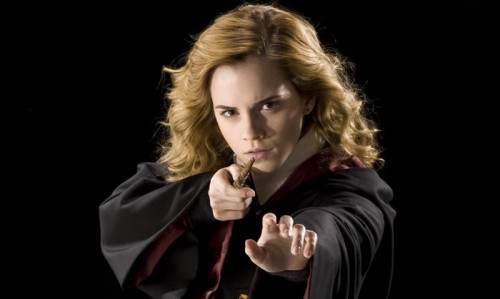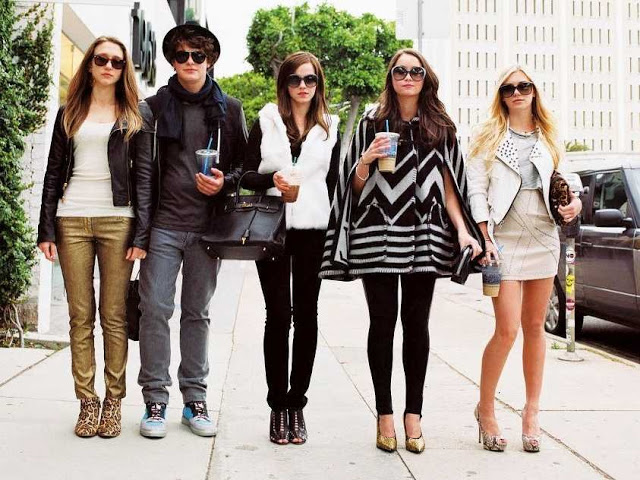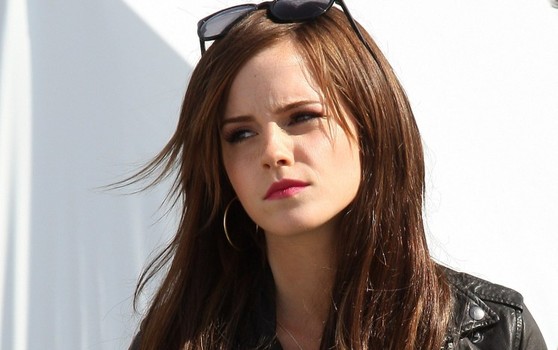
This guest post by Morgan Faust appears as part of our theme week on Child and Teenage Girl Protagonists.
In 2010, Morgan Faust, (a 35-year-old female award-winning filmmaker) directed Rachel Resheff (a 13-year-old actress recently seen on Orange is the New Black) in a short film.
They have been friends ever since.
Recently, they asked each other each five questions about young women in the movies.
Here are their answers.
Morgan: Who is your favorite teen girl character and why?
Rachel: One of my favorite teen girl characters is probably Hermione Granger from the Harry Potter movies. She never failed to hold her own in these huge films, and it was so cool to watch Emma Watson grow more and more as an actress and as a character.
Rachel: When you are writing roles for teens, do you consider the current obsessions with social media and the current “hot topics”?
Morgan: Definitely. A recent script I wrote is about a young girl who is on a hunt for her missing sister. Social media plays a huge part. As screwed up as it can be, social media gives young people a huge amount of power through community that they never had before. Since I write about young women, that is especially exciting since I think it is one of the many ways in which we are seeing barriers being torn down through technology. But I am also 35, so as you know from working with me, I spend a lot of time talking with young women to make sure my characters sound like real teenagers, not weird 35-year-old people trying to sound like kids, especially when I am talking about “hot topics”….

Morgan: Which movie character is most like you?
Rachel: I think I am a lot like Emily from Pretty Little Liars (my favorite show). Emily is smart and driven. In the show, she faces many obstacles that can get in the way of her passion for swimming. I can relate to Emily because as I pursue my passion for acting, there are many obstacles that can get in my way and people who can try to put me down. Also, Emily, like me, finds time to still have fun and she stays close to the people who are always there for her.
Rachel: Do you ever write about experiences from your childhood?
Morgan: There is no other young woman I know better than the one still alive and kicking in my head. I often have to remind myself in situations that it is in fact I who is the grown-up. So, yeah, a lot of my personal stories end up in my writing. I grew up a tomboy, playing in the mud and jumping car batteries, and a lot of my characters end up that way. Since I write adventure and fantasy, usually my characters’ experiences are elevated beyond my own, but the feelings and the reactions are the same. I want to fill the screens with self-reliant young women who use their brains to solve problems and learn how to make good decisions, so when I write young women characters, I am often mixing “what I did do” with “what I wished I had done” (I think it’s only fair that my characters get to be cooler than me!).
Morgan: What do you think of the Disney Princesses?
Rachel: I think that the Disney Princesses made my childhood complete and I will forever be grateful for the impact they made on my life… seriously. But, I also feel that they can give little girls a false sense that every girl needs to be a princess with a Prince Charming. So much has changed with the idea of acceptance, and that’s why I think that the Disney Princesses are becoming a little bit different. They are not really the girls who get put into comas and need princes to come and wake them up anymore. Usually now, Disney Princesses are the ones doing the rescuing, which I think is symbolic of a lot of things that young girls should learn. Not that I have lived that long and I am that old, but I definitely have strong opinions about these sort of things.

Rachel: What is your opinion on the child starlets who have ended up in some trouble as young adults?
Morgan: As a woman old enough to be a mom, but without kids, I find myself torn on this issue. As the mom I will one day be, I see these young women expressing themselves often in incredibly sexualized ways and think, they have a responsibility as professional famous people to consider the impact they have on their fans. The unmarried, mom-less me can fully connect to the undeniable pressure they are under, the very real mental toll their lives have taken on them and their desire to just break free! All I can do as an artist is continue to try and create worthy, interesting and cool (which even using that word, I feel I am putting into question my ability to do so) young women on the screen that kids and teens (and grown-ups that like to watch teen movies…) connect with. Stories serve as more than just entertainment, they serve to help us invent our own codes of morality and integrity. I am not looking to make Little House on the Prairie-type characters devoid of darkness and flaws, but I do hope to put a lot more girls and women on the screen that don’t think their looks are the only important thing about them.
Morgan: What do you think of Miley Cyrus?
Rachel: I actually don’t have a problem with all of Miley Cyrus’s recent actions. I looked up to her when I was younger because she was a very positive role model to young girls. Now, in her new phase, she is trying to send a different message by saying that everyone should just be totally comfortable in their own skin and no one should care what anyone else thinks. I completely support her new views but sometimes, like in her VMAs performance or her appearance where she smoked a joint at the EMAs, she goes a little bit overboard. But, the idea of doing what makes her feel happy and comfortable is fine as long as she’s not doing something that can get her in jail or under psychiatric evaluation. Sometimes it seems that with child actors/ actresses who grow up in the public eye, they don’t want to be perceived the way they were when they were kids as sweet and innocent, so they can take it to extremes. I try to keep myself balanced as a child actress, and when I grow up, I will try my best to not let myself go crazy. Personally, “Nobody’s Perfect” by Hannah Montana (Miley Cyrus) will always be my jam no matter what.

Rachel: As a director, what do you look for in teens/young women, when you are casting?
Morgan: Personality, intellect, heart, a good work ethic, and connection. We’re going to be doing a lot of hanging out, so we better get along. They have to be right for the role, but if I connect with someone, I am willing to take a leap of faith that together we can grow the character to be a blend between the person I imagined, and the person they are.
Morgan: Do you think teenage girls are presented as too sexy or pretty normal in the way they dress and behave as compared to you and your friends?
Rachel: I don’t really feel that teens are presented as too sexy or anything like that. Typically, the teens in movies or TV shows usually dress and act similar to how my friends and I act at school or just in general. However, I find a lot of times that writers have the teens use a lot of text-talk and over-exaggerate the current obsession with social media. Sometimes the writing can become unrealistic or unnatural. I often recognize as the actress in the scene when something sounds like it is something a kid in my school could say or if it isn’t.

Rachel: Which child actresses from when you were a kid have influenced you as a writer/director and why?
Morgan: OK, she’s not exactly a kid, but definitely Jennifer Grey. Her role in Dirty Dancing was this smart, goofy, fearless, normal looking girl that just felt so real on the screen, and who succeeded through hard work and following her heart. It was sweet. I think about her a lot. She was just the perfect actor for the perfect role.
The truth is when I was growing up in the 1980s, the child actresses were often given pretty syrupy roles (with the exception of Journey of Natty Gann and Labyrinth). It was the boys who got to have the cool movies–Goonies, Stand by Me, even The NeverEnding Story and E.T., which did have girls, but the boys were the heroes. That is why I write the movies I do–adventures films for girls–because that’s what I wanted to do when I was a kid, go on adventures, be the hero. I still do want that. I mean, who doesn’t? It’s exciting to see more Hunger Games (well, at least the idea of Hunger Games, I’d prefer a more active protagonist who makes a decision every once in a while instead of just having a series of gut reactions, but that is a different interview…) and Divergent. Let’s keep ‘em coming on every budget level!
Morgan Faust started working in film as an intern for the Squigglevision classic Dr. Katz and never looked back. A graduate of Columbia University’s MFA program, she now works as half of BroSis, a brother/sister writing and directing team with brother Max Isaacson in Los Angeles, where they are finishing up their first feature script (a female-helmed actioner), and ramping up to direct a pair of films in 2014. Her short film Tick Tock Time Emporium won numerous film festivals and is distributed in the US, India, Greenland, Denmark, the Faroe Islands and is available online at Seed & Spark. Her other credits include Gimme the Loot (Editor), 3 Backyards (Editor) and Mutual Appreciation (Producer).
Rachel Resheff, age 13, began working at age 8 when she appeared in the indie film, 3 Backyards, where she first met Morgan Faust. Since then, Rachel has appeared in four Broadway productions, numerous Off-Broadway plays, films, and television (most recently in Orange is the New Black as Young Alex).





